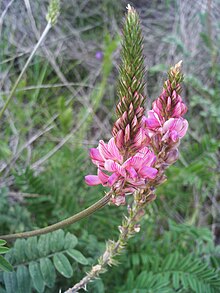Onobrychis viciifolia
| Common sainfoin | |
|---|---|
 |
|
| Scientific classification | |
| Kingdom: | Plantae |
| (unranked): | Angiosperms |
| (unranked): | Eudicots |
| (unranked): | Rosids |
| Order: | Fabales |
| Family: | Fabaceae |
| Subfamily: | Faboideae |
| Genus: | Onobrychis |
| Species: | O. viciifolia |
| Binomial name | |
|
Onobrychis viciifolia Scop. |
|
| Synonyms | |
|
Hedysarum onobrychis |
|
Hedysarum onobrychis
Onobrychis sativa
Onobrychis viciifolia, also known as O. sativa or common sainfoin has been an important forage legume in temperate regions until the 1950s. During the Green Revolution it was replaced by high yielding alfalfa and clover species. Due to its anthelmintic properties the common sainfoin is a natural alternative to drugs to control nematode parasitism in the guts of small ruminants. This is the main reason why O. viciifolia came back to the scientific agenda during the last years.
The genus Onobrychis comprises 54 different species of which O. viciifolia is of greatest agronomic importance. Two different agricultural types of O. viciifolia are known. The single-cut type is characterized by a vegetative regrowth after cutting and its origin is in Europe. A generative regrowth after cutting is typical for the second or the double-cut type. Originated in the Middle East the double-cut type grows larger than the single-cut type. Compared to other forage legumes both types are weak in competition and their regrowth after mowing is considered to be low. Also the yields of common sainfoin are significantly lower than those of alfalfa and clover.
In terms of symbiotic nitrogen fixation from the atmosphere, common sainfoin is not as specific as other legumes. A relatively broad range of rhizobia genera is able to colonize the roots of O. viciifolia. The common sainfoin is an open pollinating plant, mainly pollinated by nectar feeding insects. Therefore, O. viciifolia is a promising crop to enhance biodiversity within agro-ecosystems. This pollination biology leads to certain difficulties in breeding programs resulting in a low number of registered cultivars. The leaves of common sainfoin contain high levels of condensed tannins. This content can be more than five times higher than in clover species or alfalfa .
An animal diet containing common sainfoin is able to reduce nematode (e.g. Haemonchus contortus) parasitism in ruminant’s guts. Due to the high levels of condensed tannins, the fecundity of nematodes and the number of their eggs in the ruminant’s digestive system are reduced. Especially in goat and sheep production systems feeding of O. viciifolia is a promising alternative or complement to synthetic drugs. Besides these anthelmintic properties diets containing common sainfoin can lead to increasing daily weight gains of small ruminants. Also milk quantity and quality of these animals are not negatively affected by O. viciifolia intake. Furthermore, various studies showed that the voluntary intake of sainfoin was comparable or even higher than the intake of alfalfa or clover species.
...
Wikipedia
